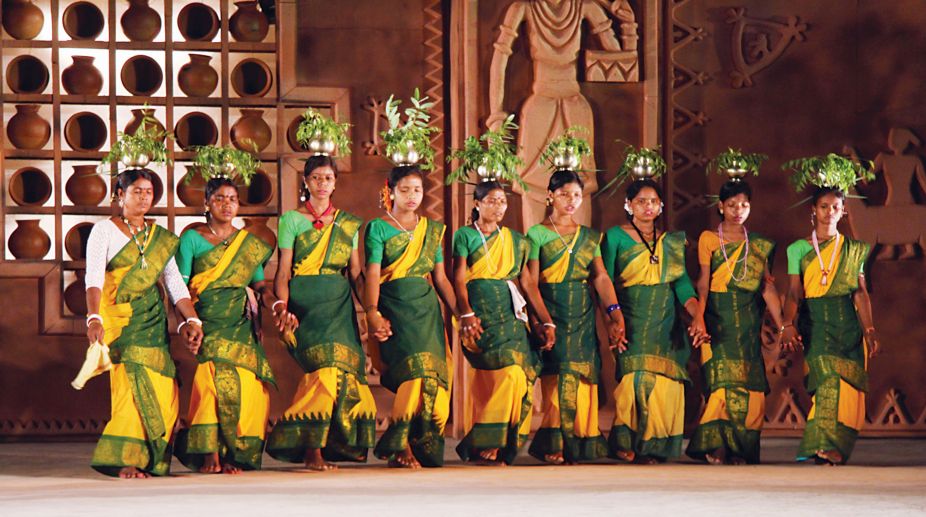City witnesses painting, hand scrolls of artist Benodebehari
A unique exhibition on Scenes from Santiniketan and Benodebehari’s hand scrolls was inaugurated in the city on Saturday.
The festival Adirang Mahotsav organised by National School of Drama was a celebration of India’s vast folk tradition through dance, theatre, crafts fair and more.

Everyone was in a grand mood for all the three days when they thronged at Dwaronda, a village 12 kilometers away from Santiniketan. It was the sixth year when the National School of Drama officials arrived from New Delhi to organise the festival titled Adirang Mahotsav.
When Ratan Thiyam, former chairman, NSD, gave shape to this festival six years ago, it was named Adibimb which was converted to Adivasi Adibimb few years later.
Now, in the hands of acting chairman Arjun Deocharan, director Waman Kendre and registrar Pradip Mohanti, the festival has progressed steadily.
Recently, the inaugural session witnessed all the 350 participants from 15 Indian states performing at a time on the stage in a choreographic pattern.
Advertisement
Choreographer Laique Hussain, assisted by Prabuddh Pandey arranged presentations of dance forms from different states on one thread. When one group took centre stage, others were waiting surrounding the performing group. Thus viewers got a glimpse of all the dance forms to be performed on the next two days.
Ho Munda dance from Odisha, Jharkhand and Chhattisgarh revolves around their village life. Ho people are an ethnic group of India. Their songs are generally accompanied by dances which change with the seasons and distinctively choreographed giving the flavour of Ho culture and art, especially their traditional festival Maghe Parab. Their music incorporates native instruments like dholok, dumeng (mandar) and rutu (flute).
A dance from Arunachal Pradesh caters to the message about child marriage. This dance depicted the marriage of two teenaged sisters who remembered how they shared their clothes and jewellery with each other before marriage.
Mugyanta, a dance from Nagaland, is performed by the women of the Lotha tribe in their full traditional attire. They showed their love for birds singing and dancing in the hills. They also invoke the spring season through this dance as it brings new life.
Kharsawan Chhau belongs to Seraikela. This is known as the hunter dance. In the state of Jharkhand when people are successful in hunting, men and women express their happiness by performing this dance.
Paika is a typical dance of Oraon and Munda communities of Jharkhand. Performed with accompaniment of dhak, nagara and shehnai, this dance form mainly shows the preparation for war connected with rituals. Chest blades, multi-coloured headgears, anklets, bows, arrows, spears, swords and shields helped them to enact the battle scenes perfectly.
Kinnauri Nati dance from Himachal Pradesh looks similar to the Bhangra of Punjab which is celebrated to represent happiness after a good harvest.
Thang Ta is a special art form of Manipur. “Thang” means sword and “Ta” means spear. This is a traditional martial art, artistically displaying the skill of self defense and thus leaving the audience spellbound.
Amongst the dance presentations, Ranapa Nritya of Odisha needs mention for its distinct nature. It is a popular form of the cowherd community of Ganjam. Ranapa means dance on stilts performed with instruments like Dhol, Mahuri and Janja. Some say that the form is associated with the boyhood exploits of Lord Krishna. The other opinion is that people used to walk on stilts to cover long distances in the pre-independent India.
In fact it has been a vital force in promoting the folk dances of the region for last one decade and above but this is the first time the group is joined by a female dancer named Swachhaprabha who took the key role with expertise.
Ganjam’s Tiger dance is also notable which is identified as War and Hunt dance marked by painting bodies and wearing masks of tiger.
Theatre was an integral part of the festival. Machakandana Ra Swara is a story about a tribal leader Dharanidhar who revolted against the British and the regional king Dhanurjay to protect the poor people from serving as slaves. This was directed by Dhira Mullick of Satabdira Kalakara from Odisha.
Another play Linjin Da in Santhali, based on Rabindranath Tagore’s Muktadhara, directed by Partha Gupta, captivated the audience for its overall stylisation.
The entire event was performed on three stages meant for music, dance and theatre respectively at three different corners at a huge open venue. It won’t be an exaggeration to say that the remarkable installations at different points (from entrance to backdrop of the stage) by Anup Giri added beauty to the venue.
An elaborate Crafts Mela was an added attraction of the festival. A variety of handiworks from 17 states were displayed highlighting the specialties of each region. Leather foot wear from Udaipur, green cane and bamboo products from Meghalaya, coconut shell work from Puducherry, bone craft from Gaziabad, handmade paper (rare product) from Chittorgarh, cloth toys from Ahmedabad, sikki grass craft from Madhubani were some of the most attractive items on sale.
Guwahati’s Kaziranga National Park Animal Saris cost Rs 2,000 and Assamese kurtas were available for Rs1,500.The sellers admitted that there was not much income but yet they have no regret because it was a grand opportunity for them to showcase their products before such a wide gathering. Dwaronda’s sweets—Patisapta, Dudhpuli and Gokul Pithe had a great demand.
Advertisement